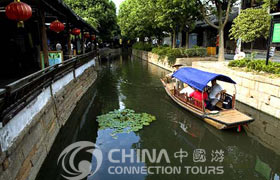
 Located 18 km. east of the city of Suzhou in the Lake Tai basin, Luzhi is a well preserved ancient Venetian township. Archaeological finds show that man lived here as early as Neolithic times. To the south of the township is a Neolithic cultural site called the Mounds of Zhanglin. Eleven Neolithic tombs were discovered along with stoneware, jade, and pottery funerary objects there in 1977.
Located 18 km. east of the city of Suzhou in the Lake Tai basin, Luzhi is a well preserved ancient Venetian township. Archaeological finds show that man lived here as early as Neolithic times. To the south of the township is a Neolithic cultural site called the Mounds of Zhanglin. Eleven Neolithic tombs were discovered along with stoneware, jade, and pottery funerary objects there in 1977.
By the end of the 6th century B.C. the Wu Kings, Helu and Fuchai, successively built the Wu King Palace, the Firmiana Simplex Garden and other imperial palaces for short stays away from the capital. In the 4th century A.D. the ancient township, then called Fuli, became a trading post thanks to convenient water borne transport. Since the 14th century, it has become a Venetian township with a sizable population, booming businesses and a prosperous economy. The port of Zhi, with access to 6 different places was renamed Luzhi (Lu sounds similar to number 6 in Chinese), a name which it still uses today.
With a network of waterways from Lake Tai and numerous other lakes such as Lake Jincheng and Lake Wanqian, the township of Luzhi was laid out along the water in the shape of an "L", covering 47 ha. The township is crisscrossed by the Dongshi and Nanshi Canals with a number of the canal’s branches making a herring bone pattern. Spanned by many bridges, the canals are flanked by alleyways, houses and market places. Businessmen travel by boat, even for short distances, to trade with one another.
Also known as a Venetian Township of Bridges, Luzhi used to have 72 bridges, 42 of which have survived to the present day. The peaceful Venetian life, simple and rustic folk customs, bridges, market places, houses and alleyways with their strong traditional flavor offer a fine example of the harmonious relationship between people, their activities and the natural water environment.
Luzhi boasts an abundance of cultural relics. Since 1981, Luzhi has been listed as one of the major sights of China and one of the sights in the Lake Tai scenic region. Since 1995 it has been listed as the historic and cultural township of Jiangsu Province.
Today, a new district is being developed, changing ancient Mudu into a modern town open to the outside world. In this district, there are zones for industry, residences and holiday resorts. In the villa zone, four villa areas and four apartment areas have been completed with a total floor space of 400,000 square meters. The quality, environment, infrastructure and service in the zone are all excellent. In the holiday resort zone, two vocational centers, the Yangcheng Garden and Hongyun Garden, have been completed. Recreational facilities provided include a park for water sports, swimming pool, and golf course. The town has one secondary vocational school, two middle schools, two primary schools, one hospital and one cultural center.

